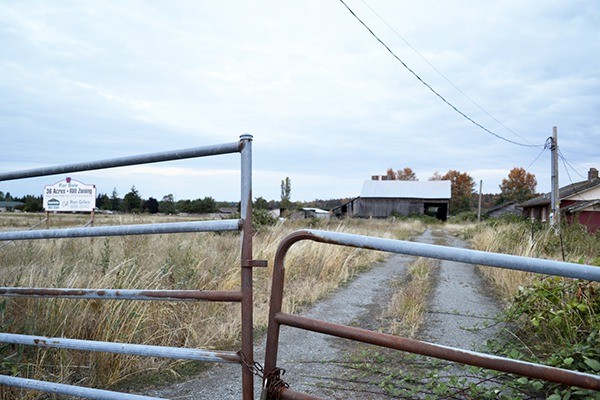Sequim city councilors opted not to move ahead with the first of several planned updates to the City of Sequim’s Municipal Code on Monday.
The changes would remove RIII, moderate density housing, and RIV, high density multifamily, zones and direct future development like those to newly zoned districts such as the Lifestyle District near Fifth Avenue and Downtown Sequim.
Chris Hugo, director of community development, said the changes would promote single-family neighborhoods and more density while promoting neighborhood centers as directed in the city’s comprehensive plan, which was approved in November 2015.
However, city councilors Pamela Leonard-Ray, John Miller, Ted Miller and Genaveve Starr voted against the amendment 4-3 after hearing testimony from real estate brokers and property owners of the Booth property at the intersection of Port Williams Road and Sequim Avenue.
The 38-acre property, which used to operate as a dairy farm, is zoned RIII, which is residential but 2 ½ acres of the property is zoned commercial.
Nancy Booth, one of the property owners, said the 38-acre property has been in their family for 80 years and they’ve been trying to sell it for several years but couldn’t until recently due to the economy. She said their developer, from Silverdale, is relying on the commercial aspect as part of a potential 250 homes project.
“With the 2 ½ acres of commercial, we didn’t think ours would be rezoned,” she said.
Neighborhood center
Hugo said there are several reasons why the Booths’ property was changed to residential for the comprehensive plan.
When he moved here almost six years ago he looked at the site as a possible neighborhood center but eventually felt the opportunity left namely because of how its neighbor Rock Plaza was developed.
Hugo said if the shopping center, kitty-corner to the Booths’ property, were built today under the plan, it would be flip-flopped so that its buildings’ fonts were facing the roundabout to encourage a more walkable neighborhood.
Hugo said planners try to keep commercial uses in one quadrant so that pedestrians don’t have to cross arterials. He added that the roundabout is a weakness because pedestrians must walk farther rather than at a four-way-stop, too.
His biggest issue is that there still wouldn’t be enough homes in the area to support new commercial development there.
“I’ve seen places with 700 living units with commercial and independent businesses that just don’t make it,” he said.
“The market just isn’t here for this.”
Hugo said that the proposed 250 homes would not be enough either, saying there examples across the country to support this.
He used Rock Plaza as an example saying there are hundreds of homes nearby it but remains more than half empty.
Hugo said the neighborhood center is a great idea but he doesn’t think it’ll work at the Booth property now.
“I want to see it in every neighborhood where it can be successful,” he said. “The worst thing that can happen is to try and push it in a place where it won’t be successful.”
Commercial growth
Deputy Mayor Ted Miller said he has a philosophical difference with city staff about commercial development and the plan’s amendments.
“The market forces should determine what commercial developments occur,” he said.
He added that the Booths’ property should keep its commercial zoning.
“Contrary to many people’s impression, residential development is a big money loser for the city,” Ted Miller said. “It costs a city far more to take care of a residential property. A commercial development is a money maker.”
Leonard-Ray said she’s bothered the corner would be for a subdivision and that the space would be wasted.
“The corner which could have commercial use and receive tax revenue is going to be the subdivision’s identity corner,” she said. “That would be a difficult place to live on that corner.”
Councilor Candace Pratt said people have lived at Peninsula Nurseries across the roundabout without moving and she added that the amendment is part of a bigger picture and the city always will receive requests for little changes.
“We’ve written the comprehensive plan and now we’re implementing it,” Pratt said. “To go back and parse every little thing in it just seems to be counterproductive.”
Leonard-Ray noted she was not on city council when the plan was approved, nor were Lake and John Miller.
Councilor Lake said he voted for the amendment because of possible zoning implications citywide with future development.
“You need a lot of people to support things and people in Sequim aren’t the type to walk to the store. A few people walk,” he said.
Ron Gilles, listing broker for the Booth property through Professional Real Estate, told the Gazette that if the amendment did go through, it likely would affect the sale.
“I haven’t seen any plans but a commercial corner was part of that,” he said.
Gilles said the property was annexed into the city 10 years ago.
He wasn’t sure if the developer would have enough time to make a concrete plan and receive necessary permitting before any future changes are made to the zoning to the property.
City Manager Charlie Bush told city councilors he’s not sure of the next steps with the amendment but they’ll need to consider interim steps for the comprehensive plan in the future.
Hugo said without the changes, the zoning code does not comply with the Growth Management Act’s mandate to implement the new Comprehensive Plan with consistent zoning.
Sequim’s Planning Commission approved and recommended the amendments on July 19 and the changes were analyzed by a focus group including two planning commissioners and three real estate brokers.
For more information on the comprehensive plan, visit www.sequimwa.gov or call 683-4908.



